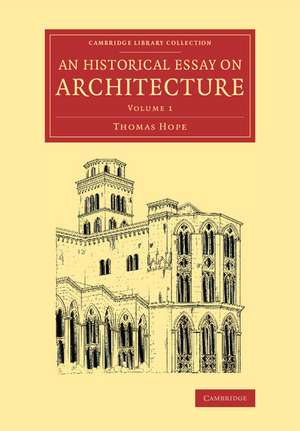An Historical Essay on Architecture: Volume 1: Cambridge Library Collection - Art and Architecture
Autor Thomas Hopeen Limba Engleză Paperback – 12 feb 2014
Din seria Cambridge Library Collection - Art and Architecture
- 11%
 Preț: 419.13 lei
Preț: 419.13 lei - 19%
 Preț: 687.98 lei
Preț: 687.98 lei -
 Preț: 228.64 lei
Preț: 228.64 lei - 23%
 Preț: 922.38 lei
Preț: 922.38 lei - 23%
 Preț: 866.28 lei
Preț: 866.28 lei -
 Preț: 179.45 lei
Preț: 179.45 lei - 23%
 Preț: 827.78 lei
Preț: 827.78 lei -
 Preț: 245.27 lei
Preț: 245.27 lei -
 Preț: 245.23 lei
Preț: 245.23 lei -
 Preț: 372.51 lei
Preț: 372.51 lei -
 Preț: 354.28 lei
Preț: 354.28 lei -
 Preț: 371.36 lei
Preț: 371.36 lei -
 Preț: 421.42 lei
Preț: 421.42 lei -
 Preț: 224.53 lei
Preț: 224.53 lei -
 Preț: 469.25 lei
Preț: 469.25 lei -
 Preț: 423.15 lei
Preț: 423.15 lei -
 Preț: 329.02 lei
Preț: 329.02 lei -
 Preț: 318.47 lei
Preț: 318.47 lei -
 Preț: 478.29 lei
Preț: 478.29 lei -
 Preț: 522.17 lei
Preț: 522.17 lei -
 Preț: 368.48 lei
Preț: 368.48 lei -
 Preț: 471.74 lei
Preț: 471.74 lei -
 Preț: 368.69 lei
Preț: 368.69 lei -
 Preț: 354.84 lei
Preț: 354.84 lei -
 Preț: 328.64 lei
Preț: 328.64 lei -
 Preț: 355.23 lei
Preț: 355.23 lei -
 Preț: 278.81 lei
Preț: 278.81 lei -
 Preț: 278.81 lei
Preț: 278.81 lei -
 Preț: 368.30 lei
Preț: 368.30 lei -
 Preț: 356.41 lei
Preț: 356.41 lei -
 Preț: 319.02 lei
Preț: 319.02 lei -
 Preț: 287.95 lei
Preț: 287.95 lei -
 Preț: 426.97 lei
Preț: 426.97 lei - 19%
 Preț: 514.46 lei
Preț: 514.46 lei -
 Preț: 467.12 lei
Preț: 467.12 lei -
 Preț: 335.55 lei
Preț: 335.55 lei -
 Preț: 446.09 lei
Preț: 446.09 lei -
 Preț: 422.55 lei
Preț: 422.55 lei -
 Preț: 422.55 lei
Preț: 422.55 lei -
 Preț: 371.74 lei
Preț: 371.74 lei - 19%
 Preț: 475.69 lei
Preț: 475.69 lei
Preț: 476.55 lei
Nou
Puncte Express: 715
Preț estimativ în valută:
91.19€ • 97.51$ • 76.03£
91.19€ • 97.51$ • 76.03£
Carte tipărită la comandă
Livrare economică 17 aprilie-01 mai
Preluare comenzi: 021 569.72.76
Specificații
ISBN-13: 9781108068413
ISBN-10: 1108068413
Pagini: 552
Dimensiuni: 170 x 244 x 28 mm
Greutate: 0.87 kg
Editura: Cambridge University Press
Colecția Cambridge University Press
Seria Cambridge Library Collection - Art and Architecture
Locul publicării:Cambridge, United Kingdom
ISBN-10: 1108068413
Pagini: 552
Dimensiuni: 170 x 244 x 28 mm
Greutate: 0.87 kg
Editura: Cambridge University Press
Colecția Cambridge University Press
Seria Cambridge Library Collection - Art and Architecture
Locul publicării:Cambridge, United Kingdom
Cuprins
Preface; 1. Introduction; 2. Origin and nature of the Egyptian style of architecture; 3. Origin of the architecture of the Greeks; 4. Influence upon architecture of habit and religion; 5. Nature and character of the different orders of Grecian architecture; 6. Natural and adventitious circumstances by which Grecian architecture was affected; 7. On the origin of the arch; 8. Decay of the architecture of the Greeks, and progress of that of the Romans; 9. Effect upon architecture of the introduction of Christianity; 10. Effect upon ancient architecture of the want of glass; 11. Some account of round or polygonal buildings; 12. Rise and progress of the architecture of Byzantium; 13. Derivation of the Persian, Mohammedan, and Moorish architecture from that of Byzantium; 14. Derivation of Russian architecture from that of Byzantium; 15. Destruction of pagan works of art; 16. Symbols used by the early Christians; 17. Heathen customs kept up or emulated by the Christians; 18. Schism between the Greek and Latin churches; 19. Sepulchral architecture; 20. Early styles of architecture on this side of the Alps derived from Italy; 21. Investigation of the circumstances which, towards the end of the tenth century, affected architecture generally and extensively throughout Europe; 22. Lombard style of architecture; 23. Progress of the art of constructing arches and vaults; 24. Forms of the absis, entrance, cupola, spire, and steeple usually seen in Lombard architecture; 25. Lombard monastic architecture; 26. Private defensive architecture of the ninth and tenth centuries; 27. Lombard civic architecture; 28. Allegorical and other ornamental additions to Lombard architecture; 29. On the use of brick; 30. Doors of churches; 31. A list of churches in the Lombard style; 32. Some account of the characteristics of the pointed style; 33. The question of the person by whom, or the place where, the pointed arch was invented, not to be solved; 34. Examination of various conjectures on the subject of the change from round to pointed architecture; 35. The author's theory respecting the invention and adoption of pointed architecture; 36. A brief examination of various conjectures as to the country in which pointed architecture originated; 37. Inquiry into the claims of England to the invention of pointed architecture; 38. Inquiry into the claims of France and Italy; 39. Inquiry into the claims of Germany; 40. A short account of some developments of the pointed style, religious and civic; 41. Diffusion of the pointed style through France, England, Spain, Portugal, and Italy; 42. A list of remarkable edifices in the pointed style; 43. Local peculiarities of architecture; 44. Causes which produced the decline of pointed architecture; 45. Characteristics of the resumed style of the ancients; 46. Adoption throughout Europe of the resumed style of the ancients; 47. A list of edifices in the cinque-cento style; 48. Remarks upon architecture since the time of Michael Angelo; Index.
Descriere
The 1840 third edition of a work tracing the evolution of architecture since antiquity, accompanied by drawings and an analytical index.
